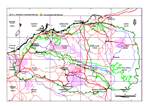Botanical name
Acacia drepanocarpa subsp. latifolia Pedley, Contr. Queensland Herb. 15: 10, 19, figs 2A & 6 (1974)
Description
Spreading, obconic, multi-stemmed glabrous shrubs 1-3 m tall. Bark smooth. Branchlets marked with crenulate resin ribs (observe at x10 magnification) at extremities, yellow or yellow-green. Phyllodes narrowly elliptic to narrowly oblong-elliptic, 4-6 cm long and (6-) 8-12 mm wide with l:w = 5-8 in Pilbara populations, erect, straight to shallowly (sometimes moderately) incurved, green to yellow-green; with numerous, rather widely spaced, raised (when dry) resinous longitudinal nerves, 3-5 more pronounced than the rest, sometimes with a few obscure, anastomosing minor nerves between the main nerves; apex terminated by a short, thickened callose point. Gland situated on upper margin of phyllode 0-2 mm above the pulvinus. Inflorescences simple, 1 or 2 initiated within axil of young phyllodes towards ends of branchlets; peduncles 4-12 mm long; spikes 10-35 mm long (when fresh), showy, bright golden, often the old (pale yellow) spikes persist on plants for some time following anthesis, the flowers close together. Flowers 5-merous; calyx shortly dissected into broadly triangular lobes, white membranous. Pods narrowly oblanceolate, narrowed towards the base, 5-8 cm long, 8-9 mm wide, erect, woody, opening elastically (and explosively) from the uncinate apex with the dehisced valves recurved, obliquely nerved, yellowish at maturity. Seeds oblique and seated in shallow yet distinct chambers, ellipsoid to obloid-ellipsoid, 5-6 (-6.5) mm long, 2.5 mm wide, shiny, mid-brown; pleurogram bordered by a narrow band of dull yellow tissue; funicle-aril straight, white and narrowly turbinate.
Characteristic features
Branchlets yellow or yellow-green and marked with crenulate resin ribs (observe at x10 magnification) at extremities. Phyllodes relatively short and broad (mostly 4-6 cm x 8-12 mm), with few, rather widely spaced longitudinal resinous nerves which are raised when dry. Spikes bright golden, the flowers densely arranged. Calyx white membranous. Pods flat, narrowed towards the base, opening elastically from the apex with the dehisced valves recurved. Seeds oblique in pods; funicle-aril straight, white and narrowly turbinate.
Distribution and ecology
Acacia drepanocarpa subsp. latifolia extends from northwest Queensland through Northern Territory to the southern Kimberley region of Western Australia, then south to the western extremity of the Great Sandy Desert. Although this subspecies is not yet recorded from within the Pilbara region, it occurs only a kilometre or so outside its eastern boundary, in the Little Sandy Desert near the Gregory Range (about 300 km southeast of Port Hedland). Subspecies latifolia is often common in the places where it occurs. The near-Pilbara plants grow in red or well-drained loam sand, at the base of granite rises and in dune swales, with spinifex ground cover. Elsewhere it is commonly reported as growing in sand or gravelly sand, often over laterite.
Flowering and fruiting period
Over its geographic range this subspecies flowers from May to July (Pilbara plants in flower in mid-July) and mature pods are present in September (but are likely to extend to about November; Pilbara plants were in very young pod in late August).
Variation
The Pilbara plants of subsp. latifolia have consistently short, broad phyllodes (4-6 cm long and (6) 8-12 mm wide with l:w = 5-8) but over its geographic range the phyllodes are sometimes slightly longer (4-8 cm), narrower (4-11 mm) and with l:w = 5-15.
Taxonomy
The taxonomic status of A. drepanocarpa in Western Australia needs to be reassessed. Although two entities referable to A. drepanocarpa are recognized within, or near, the Pilbara region, namely, A. drepanocarpa subsp. latifolia and A. drepanocarpa (variant), it is possible that future studies will consider these to be part of a single variable taxon. Acacia drepanocarpa (variant) occurs in the vicinity of Shay Gap, about 150 km northeast of where subsp. latifolia is found; it differs from subsp. latifolia in having generally narrower phyllodes. A related species, A. ptychophylla also occurs in the vicinity of the Gregory Range where it is normally found on rocky hills and is distinguished from subsp. latifolia by its reddish brown penultimate branchlets (yellow or light green at extremities), its generally shorter (and broader) phyllodes with two or more glands along their upper margin. Acacia drepanocarpa subsp. drepanocarpa which occurs at the western edge of the Great Sandy Desert north of the Pilbara region (it is commonly seen along North West Coastal Highway in the vicinity of Anna Plains and Frazier Downs stations) has long, narrow phyllodes which are mostly 1-2 mm wide.
Conservation status
Despite being rare in the Pilbara region subsp. latifolia has a wide distribution outside the region and is not considered rare or endangered.
Origin of name
The species name is derived from the Greek drepanon (sickle) and karpos (fruit), presumably because the pods were originally described by Ferdinand von Mueller as 'subfalcate' (i.e. slightly curved). However, this would seem to be an inappropriate name for this species as the pods are more typically straight (except following dehiscence where the pod valves are recurved). The subspecies name is derived from the Latin lati- (broad, wide) and -folius (leaved) in allusion to the broad phyllodes that distinguishes this subspecies from the typical subspecies.


